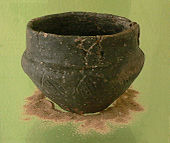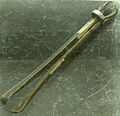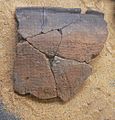Iron Age settlement near Bantorf
Coordinates: 52 ° 20 ′ 18 ″ N , 9 ° 25 ′ 19 ″ E
| Iron Age settlement near Bantorf | ||
|---|---|---|
|
View of the logistics warehouse of the grocery chain Kaufland in the Bantorf-Nord industrial park. The Iron Age settlement was roughly on the site of the large building on the left with the red company logo. |
||
| location | Lower Saxony , Germany | |
| Location | Bantorf | |
|
|
||
| When | pre-Roman Iron Age around 500 BC Until the beginning of the Roman Empire | |
| Where | Bantorf , Region Hannover / Lower Saxony | |
The Iron Age settlement near Bantorf was a prehistoric settlement that dates back to around 500 BC during the pre-Roman Iron Age . Existed until the beginning of the Roman Empire around the birth of Christ. It was near Bantorf , a current district of Barsinghausen on the western edge of the Hanover region in Lower Saxony . Remains of the early Germanic settlement, which is over 2000 years old , were discovered during construction work in 2011, which led to an archaeological rescue excavation lasting several months .
excavation
The settlement was discovered in 2011 during construction work to enlarge the Bantorf-Nord industrial park on the BAB 2 . It lay in an open field northeast of Bantorf and west of Wichtringhausen . The first finds were made during construction work for a rainwater retention basin in March 2011, when an archaeologist observed the removal of the topsoil . In the course of the rescue excavation, further discoveries were made on the extensive construction site for the logistics warehouse of the grocery chain Kaufland . The construction plans had been known since 2008. During the first prospecting measures through an inspection of the future building site in 2009, there were no indications of archaeologically significant findings. An evaluation of aerial archaeological recordings was also negative and did not lead to the detection of vegetation features . The excavation, carried out by an excavation company and accompanied by the Lower Saxony State Office for Monument Preservation , lasted from March to July 2011. The total area investigated was 7 hectares, the individual excavation areas much smaller. According to the polluter-pays principle laid down in the Lower Saxony Monument Protection Act , the two companies that had construction work carried out on the site bore the excavation costs. For the smaller area of the rain retention basin, they should have been 75,000 euros.
Finds
The archaeological investigations led to the discovery of the floor plans of five larger, multi-aisled houses and two pit houses . A total of 524 discoloration of post pits was found. In addition, several belonging to the settlement were at the site storage in post construction found and inventories as well as waste pits excavated. The settlement could not be fully explored because it continues on a site that was built over with a large complex of buildings years ago.
The pottery found was very extensive and in some cases well preserved. Other findings were colored glass beads, presumably by a chain, a pair of tweezers from bronze , loom weights and a concave mirror nobility of bronze. Small pieces of bones were also found from animals that had apparently served as food for the residents. However, the bone material has been poorly preserved in the lime-poor loess soil .
Nienburger cup

Found items from the Nienburg cup belong to the pottery . This pottery is attributed to the Nienburg group , which was located in what is now Lower Saxony during the early Iron Age from the 6th to 5th centuries BC. Formed. The Nienburger cup is a ceramic vessel that is artfully decorated and has a handle at the edge. The cultural group was named after a burial mound field in Erichshagen near Nienburg as the first place where ceramics were found.
rating
According to the archaeologists, it was a simple rural settlement with provisions and domestic animals. The lack of metal objects as well as the find situation suggested that it was abandoned and relocated as an early Germanic settlement around the 1st century. In terms of extent, it is a large archaeological site for Lower Saxony . Because of the size and geographical location north of the Deister , it is assumed that the settlement was at a junction of trade routes, such as the Hellweg .
presentation
In September 2012, on the occasion of the excavation in 2011 in the town hall in Barsinghausen, an exhibition under the tenor “7 hectares of prehistory. Bantorf-Nord, an Iron Age settlement on Hellweg ” with individual finds. This presentation was felt to be necessary on site, because otherwise the finds would be stored unseen for the population in the Lower Saxony State Museum in Hanover . At the exhibition, the found post holes of an Iron Age residential building were painted on the floor on a scale of 1: 3. Storage and rubbish pits were also marked on the ground in this way. Individual reconstructed and restored finds such as ceramics, metal parts and pieces of clay were shown in showcases. Under the motto “How did the people in Barsinghausen live in the time 500 BC. Christ? ” The exhibition not only dealt with the excavation, but also provided an insight into the living conditions of people during the Iron Age. The working methods and tools of today's archaeologists were also shown.
Gallery finds
literature
- Friedrich-Wilhelm Wulf : Early Teutons on 40,000 m² in: Archeology in Germany July / August 2011 ( online , PDF, 147 KiB).
- Katharina Malek , Wiebke Köhne-Wulf, Vijay Diaz: 7 hectares Prehistory: Bantorf-Nord - an Iron Age settlement on Hellweg. In: Reports on the preservation of monuments in Lower Saxony , Hameln 4/2012 ISSN 0720-9835
Web links
- Description of the archaeological area investigations in Bantorf as an extract from: News from Lower Saxony's Prehistory , Supplement 16, Lower Saxony Fund Chronicle 2011
Individual evidence
- ↑ Remnants of settlement also on Kaufland property in: DEWEZET from March 24, 2011 ( page no longer available , search in web archives ) Info: The link was automatically marked as defective. Please check the link according to the instructions and then remove this notice.
- ↑ Excavation site of national importance in: Schaumburger Zeitung of May 11, 2011 ( Memento of April 30, 2016 in the Internet Archive )
- ↑ Reports on the preservation of monuments 2014/4







